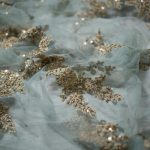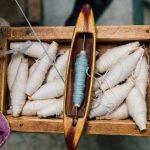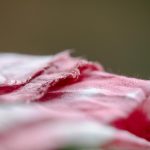When you're considering gossamer versus net fabrics, you'll quickly notice they each bring unique qualities to the table. Gossamer's delicate, ethereal aesthetic is perfect for soft, romantic looks, while net fabrics provide a sturdier structure that's often more practical for everyday use. But as you weigh their attributes, you might wonder which one truly fits your project needs and budget. Is it worth investing in the fragility of gossamer, or do the robust characteristics of net fabrics better serve your vision? Let's unpack these differences further.
Table of Contents
Defining Gossamer and Net Fabrics
Gossamer fabrics are lightweight and delicate, while net fabrics have an open weave that creates a more structured appearance.
When you think of gossamer, picture airy, sheer materials often used for layering or adding a touch of elegance to garments. These fabrics flow gracefully, providing a soft drape that enhances movement and texture. You might encounter gossamer in evening wear or ethereal costumes, where its lightness creates a dreamy aesthetic.
On the flip side, net fabrics offer a stark contrast. Their open weave allows for breathability and a more defined shape. You'll find netting used in various applications, from fashion to home decor, including overlays and veils. The structure of net fabrics gives you the ability to create bold visual elements in your designs, whether in a layered dress or as a backdrop.
Both fabric types serve unique purposes in fashion and design, each bringing their own character and versatility. When choosing between gossamer and net fabrics, consider the look and feel you want to achieve. By understanding their distinct qualities, you can make informed decisions that best suit your creative projects.
Fabric Composition and Characteristics
Both gossamer and net fabrics showcase unique fabric compositions that influence their characteristics and applications in design.
Gossamer is typically made from lightweight materials such as silk, nylon, or polyester, giving it a delicate and airy feel. This composition allows for a translucent appearance, which is great for layered looks or adding soft texture to garments.
On the other hand, net fabrics are usually crafted from synthetic fibers like nylon or tulle, offering a more structured quality while remaining lightweight.
Here are four key distinctions between their compositions and characteristics:
- Weight: Gossamer is extremely light, almost weightless, while net fabrics have a slightly heavier structure due to their weave.
- Translucence: Gossamer tends to be more translucent, allowing light to filter through, making it ideal for ethereal styles.
- Durability: Net fabrics often exhibit higher durability due to their tighter weave, making them suitable for items requiring more support.
- Stretch and Flexibility: Gossamer generally has less stretch compared to net fabrics, which can often be more adaptable in fit.
Understanding these differences helps you choose the right fabric for your design needs.
Texture and Feel Comparison
When comparing gossamer and net fabrics, you'll notice distinct differences in texture and feel.
Gossamer boasts a silky softness that drapes elegantly, while net fabric presents a more structured and open weave.
Understanding these texture traits can help you choose the right fabric for your project.
Gossamer Softness Characteristics
The soft, airy feel of gossamer is often compared to the more substantial texture of net fabrics, creating a unique contrast in tactile experience. When you touch gossamer, you'll notice its lightweight and delicate nature, making it feel almost like a whisper against your skin. This quality sets it apart from net fabrics, which tend to have a firmer, more coarse texture.
Here are some key characteristics that emphasize gossamer's softness:
- Feathery Texture: Gossamer's ethereal softness can feel similar to the lightest feathers, giving it an almost magical quality when worn.
- Sheer Lightweight: Its transparent, diaphanous nature allows for an airy sensation, perfect for layering without added bulk.
- Gentle Drapability: You'll appreciate how gossamer cascades smoothly, creating beautiful, flowing silhouettes that enhance wearability.
- Luxurious Comfort: Wearing gossamer against your skin feels sumptuous, making it a top choice for those seeking elegance without sacrificing comfort.
With gossamer, you encounter a fabric that not only looks beautiful but feels delightful, showcasing a unique blend of softness and sophistication.
Net Fabric Texture Traits
Net fabric offers a distinct texture that contrasts sharply with gossamer, showcasing a firmer and more structured feel that can add depth to any garment. When you touch net fabric, you'll notice its unique weave, which creates a mesh-like appearance. This openness provides ventilation, making it a popular choice for dancewear, sports bras, or overlays, enhancing movement and breathability.
In comparison, gossamer feels light and delicate against your skin, giving it a soft and airy touch. While gossamer drapes elegantly, net fabric stands its ground, providing more shape and support.
You might prefer net fabric if you're looking to create bold silhouettes or structured elements in your wardrobe, as it offers a more assertive presence.
Common Uses and Applications
Considering their unique properties, gossamer and net fabrics find diverse applications in fashion, home décor, and functional uses. You'll often see these materials being put to great use in various ways that highlight their lightweight and airy characteristics.
Fashion: Gossamer is commonly used in evening wear or bridal gowns, adding an ethereal touch, while net fabrics are popular in accessories like scarves and petticoats.
Home Décor: You can use net fabrics for light curtains or as decorative overlays on table settings. Their sheer quality allows for light filtering while maintaining privacy.
Craft Projects: Gossamer is perfect for crafting delicate designs, used in DIY invitations, floral arrangements, and more, thanks to its fine texture.
Functional Uses: Both fabrics see applications in costume design, where their lightweight nature and flexibility allow for creative costumes that require flowing movement or layering.
Durability and Maintenance
When it comes to durability, gossamer is generally more fragile than net fabrics, requiring careful handling and maintenance to preserve its delicate nature. You'll want to treat gossamer gently, avoiding any rough surfaces or snagging during use.
In contrast, net fabrics are sturdier and can withstand more wear and tear, making them easier to maintain.
In terms of cleaning, gossamer often needs to be hand-washed in cold water using a mild detergent. You should definitely avoid bleach and harsh chemicals, as they can damage the fibers. After washing, air-drying is the best option to prevent shrinkage or distortion.
On the other hand, net fabrics can typically handle machine washing and drying, which makes them more convenient for everyday use.
When it comes to storing these materials, gossamer should be kept away from direct sunlight and dust, ideally folded with care or stored in acid-free tissue paper. Net fabrics are less sensitive and can be stored more casually, yet keeping them clean and dry will prolong their life.
Ultimately, if you prioritize durability, net fabrics might suit your needs better, while gossamer provides an elegant but more fragile option.
Cost and Availability Differences
While gossamer's delicate nature requires careful maintenance, it also tends to come at a higher price and may be less readily available compared to the more affordable and accessible net fabrics. If you're on a budget or need something easy to find, net fabrics offer a better solution.
Here are some key differences in cost and availability:
- Price Point: Gossamer typically costs more due to its intricate manufacturing process. You'll find net fabrics often priced significantly lower, making them a more economical choice for many projects.
- Availability: Gossamer isn't as commonly stocked in fabric stores, which can make it harder to find. On the other hand, net fabrics are widely available in various colors and styles, so you won't struggle to source them.
- Buying Options: Gossamer might require special orders or online purchases, while net fabrics are usually found both in-store and online.
- Quality Variance: You might find gossamer ranges in quality but expect uniform quality in net fabrics, making your purchase decision easier.
Considering these factors can help you decide what's best for your needs.
Frequently Asked Questions
Can Gossamer Be Used for Outdoor Applications?
Yes, you can use gossamer for outdoor applications, but it's important to consider its lightweight and delicate nature. It's best suited for temporary uses where exposure to harsh elements isn't a concern.
Are There Different Types of Net Fabrics Available?
Yes, there're various types of net fabrics available. You can find options like tulle, mesh, and organza, each offering unique textures and uses, whether for fashion, décor, or outdoor applications. It's all about your needs!
How Do Gossamer and Net Fabrics React to Dye?
When dyeing gossamer, you'll find it absorbs color lightly, giving a subtle tint. In contrast, net fabrics often take on dye more boldly, resulting in vibrant hues that stand out in your projects.
Which Fabric Is More Eco-Friendly?
When considering eco-friendliness, you'll find that gossamer typically uses fewer resources and chemicals in production. Net fabrics, often made from synthetics, can have a bigger environmental impact, especially during manufacturing and disposal processes.
Can Gossamer Fabrics Be Recycled?
You can recycle gossamer fabrics, but it depends on the specific fibers used. Check local recycling guidelines to ensure you're following the correct procedures, as some gossamer materials may need special handling or aren't recyclable.
- Sourcing Crepe De Chine Fabric by the Yard for Your Next Project - June 20, 2025
- Joann Fabric in Chino, CA: A Local Shopper’s Guide - June 20, 2025
- How to Source Curtain Fabric Directly From China - June 20, 2025







